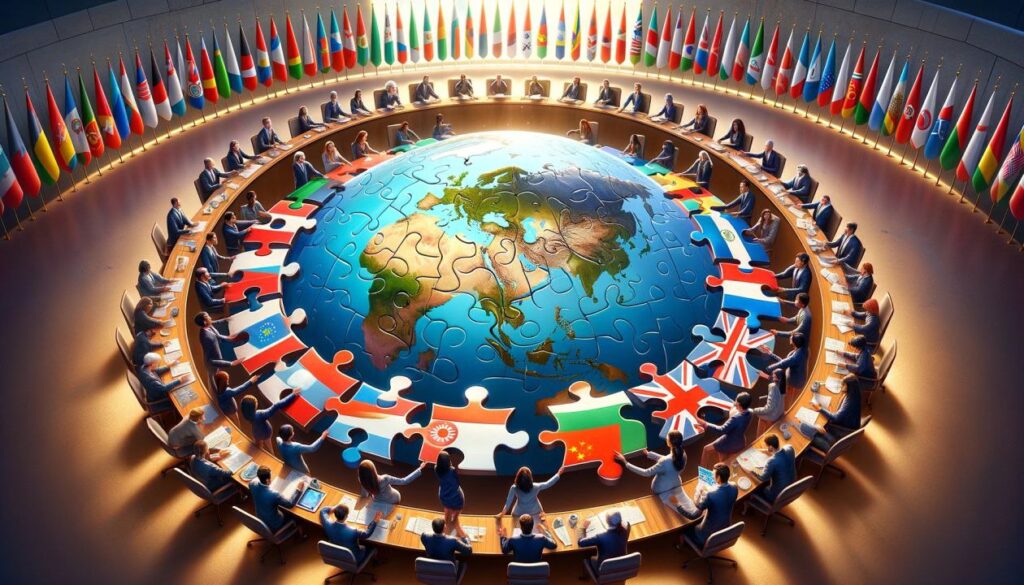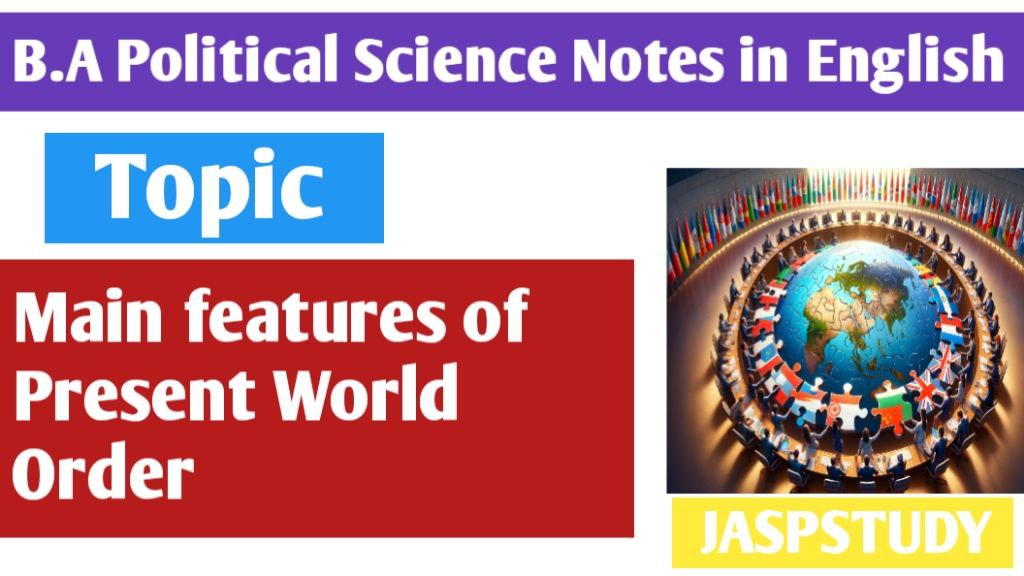In this Article we will discuss about The Main features of Present World Order. Students were eagerly waiting for this topic. In The Main features of World order, we will discuss what kind of world order emerged after the Cold War and what are its features.
The present world order refers to the global system of politics, economics, and society that exists today. It is shaped by various factors such as economic power, military influence, international relationships, and technological developments. This world order has evolved over time, especially after the end of the Cold War, and continues to change.

Main features of Present World Order
Below are the Main features of Present World Order.
1. Multipolarity and the Rise of New Powers
First Main features of Present World Order is Multipolarity and the Rise of New Powers.In the past, the world order was largely shaped by two superpowers: the United States and the Soviet Union. After the collapse of the Soviet Union in 1991, the United States became the dominant global power. However, today, the world is increasingly multipolar, meaning that there are several powerful countries, each influencing global events in different ways.
The most notable of these emerging powers are China and India. China has become a major economic and political force, especially after it began its economic reforms in the late 20th century. Its growing influence is seen in its economic strength, military power, and leadership in global organizations like the United Nations and the World Trade Organization (WTO). China’s ambitious projects, such as the Belt and Road Initiative, further demonstrate its growing global presence.
India is another rising power. With its large population and rapidly growing economy, India has gained significant political and economic influence. It is becoming an important player in global technology, space exploration, and regional security. Other countries, such as Brazil, Russia, and Japan, are also growing in importance, contributing to a more multipolar world.
- Difference between Constitution and Constitutionalism
- Traditional Methods of Comparative Study
- General Characteristics of Traditional Comparative Politics
- Main features of constitutionalism
- Growth of the Executive Powers in Modern Time
2. Globalization and Interconnectedness
Second Main features of Present World Order is Globalization and Interconnectedness. One of the most important features of the current world order is globalization. Globalization refers to the increasing interconnectedness of countries through trade, communication, culture, and technology. In today’s world, no country is truly isolated; all are part of a global network.
The internet and digital technologies have played a huge role in driving globalization. Information can now travel across the world in seconds, and people can communicate instantly, regardless of distance. Trade has become easier and faster, thanks to international agreements and improved transportation. For example, products are often made in multiple countries, with parts sourced from different locations before being assembled in one place.
Globalization has led to economic growth in many regions, particularly in developing countries. However, it has also created challenges. While some countries and businesses have benefitted greatly, others have been left behind. There is also the issue of economic inequality, as the benefits of globalization have not been equally distributed.
3. U.S. Influence and Its Challenges
Third Main features of Present World Order is U.S. Influence and Its Challenges. Although the U.S. remains a major global power, its influence has been challenged in recent years. The U.S. continues to lead in many areas, such as military power, technology, and culture, but its dominance is no longer as absolute as it once was. The rise of China, the European Union’s collective power, and other emerging nations has made the global landscape more balanced.
The U.S. is still very influential in international organizations like the United Nations, NATO, and the World Bank. Its military strength is unmatched, and its economic power continues to play a central role in global trade. However, recent events, such as trade wars, withdrawal from international agreements, and growing political divisions, have shown that the U.S. is facing new challenges. Some countries are questioning the U.S.-led global system, and new global partnerships are forming.
4. Regional Power Dynamics
Fourth Main features of Present World Order is Regional Power Dynamics. In today’s world, the influence of regional powers has increased. Countries like China, Russia, and India are exerting their influence beyond their borders, especially in their respective regions. China, for instance, has been increasing its presence in Asia, Africa, and Europe, using both its economic power and military strength.
Russia, too, has become more assertive, particularly in its neighborhood. Its involvement in conflicts like those in Ukraine and Syria has shown that it seeks to influence global events and challenge the U.S.-led order. In the Middle East, countries like Iran and Saudi Arabia play key roles in shaping regional security and political dynamics.
At the same time, smaller nations are also gaining more voice and power in global politics. Regional organizations, such as the African Union and ASEAN (Association of Southeast Asian Nations), are becoming more important in managing regional issues and promoting cooperation.
5. Technological Revolution and the Digital Economy
Fifth Main features of Present World Order is Technological Revolution and the Digital Economy. Technology is another major feature of the present world order. Over the past few decades, the world has experienced a technological revolution that has transformed nearly every aspect of life. The rise of the internet, mobile phones, and social media has changed the way people communicate, do business, and interact with each other.
The digital economy, where goods and services are exchanged online, is now a central part of the global economy. E-commerce, online banking, digital marketing, and other online services have become essential to modern economies. Big companies like Amazon, Google, and Apple are leading the way in this new digital world.
Technology is also shaping global security. Cyberattacks, where hackers target government and business systems, have become a new type of warfare. Issues like privacy, data security, and digital surveillance are becoming important in international relations.
Furthermore, advancements in artificial intelligence (AI), robotics, and biotechnology are transforming industries. These technologies offer great potential for economic growth but also pose challenges, such as job displacement and ethical concerns.
6. Global Security Challenges
Sixth Main features of Present World Order is Global Security Challenges. The world today faces a number of new security threats. While the Cold War was dominated by the threat of nuclear war between superpowers, today’s security concerns are more varied and complex. Some of the main security challenges include terrorism, cyberattacks, nuclear proliferation, and climate change.
Terrorism continues to be a major global threat. Groups like ISIS and al-Qaeda have carried out deadly attacks across the world. These groups operate in many regions and are difficult to combat, as they often do not represent a single nation-state.
Cyberattacks have also become a growing concern. Countries and businesses around the world are increasingly vulnerable to cyberattacks, which can disrupt economies, steal sensitive information, and even damage critical infrastructure.
The threat of nuclear weapons remains, with countries like North Korea and Iran seeking to develop nuclear capabilities. Efforts to prevent nuclear proliferation through international agreements like the Treaty on the Non-Proliferation of Nuclear Weapons (NPT) continue, but challenges remain.
Climate change is another major global security issue. Rising temperatures, extreme weather events, and environmental destruction are threatening the security of nations. Addressing climate change requires international cooperation and action, as no country can solve it alone.
7. Human Rights and Social Issues
Another Main features of Present World Order is Human Rights and Social Issues. Human rights, democracy, and social justice are also key features of the current world order. While the spread of democracy has been one of the main goals of the post-Cold War world, challenges remain. Many countries still face issues related to political repression, lack of freedom, and human rights abuses.
At the same time, social issues such as gender equality, racial justice, and refugee rights have gained attention on the global stage. Movements like #MeToo and Black Lives Matter have raised awareness about issues of inequality and injustice. International organizations, including the United Nations and non-governmental organizations (NGOs), continue to advocate for the protection of human rights around the world.
Conclusion
The present world order is complex and constantly changing. It is defined by a more multipolar world, where several countries, including the U.S., China, and India, play significant roles. Globalization, technological advancements, and new security challenges, such as terrorism and climate change, shape the world’s economy, politics, and security. Despite progress in some areas, many challenges remain, and countries must work together to address global issues and ensure a peaceful and prosperous future for all

